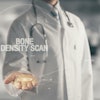
Patients who listened to a guided meditation during breast biopsy had greater reductions in pain, anxiety, and fatigue -- even more so than those who listened to music or talked to the technologist, according to a study published this month in the Journal of the American College of Radiology.
For the study, women who needed percutaneous image-guided breast biopsy were randomized into three groups: One group listened to loving-kindness guided meditation and another to music, while a standard-care control group received supportive dialogue from the biopsy team. Immediately before and after the biopsy, participants completed questionnaires measuring anxiety, biopsy pain, and fatigue.
 Dr. Mary Scott Soo from Duke University.
Dr. Mary Scott Soo from Duke University.The researchers, led by Dr. Mary Scott Soo, an associate professor of radiology at Duke University, found that guided meditation resulted in larger drops of all three measurements, while music lowered anxiety and fatigue.
"[L]oving-kindness meditation and music interventions appear safe, inexpensive, and easy to incorporate into clinical imaging-guided breast biopsy practice, and seem to improve women's experiences -- lowering anxiety and fatigue, and loving-kindness meditation resulting in lower biopsy pain," she said in an interview with AuntMinnie.com.
Why improve needle biopsies?
Compared to open surgical procedures, needle biopsies decrease costs and reduce delays, and they are highly accurate and less invasive, requiring only local anesthesia, Soo said. However, biopsies are typically performed in the outpatient setting, which limits the use of intravenous sedation and pain medication that could address commonly experienced patient anxiety and occasional associated pain.
"Anxiety and pain can negatively impact the patient's experience and could possibly affect the biopsy outcome due to patient movement, and could potentially even alter patients' adherence to follow-up recommendations," she added.
Soo and colleagues sought to determine how to address this in their study (JACR, February 4, 2016). Previous studies have explored methods such as music, hypnosis, and anxiolytics to reduce anxiety, which appear effective to varying degrees; however, hypnosis and anxiolytics are more complicated to implement due to training and costs for administering hypnotherapy, as well as the potential side effects and need for an adult driver to take patients home after sedation.
Loving-kindness meditation
Prior research indicated that several meditation-based interventions could be beneficial for improving medical outcomes in a variety of settings: In particular, a seven-minute loving-kindness meditation proved effective for increasing positive emotions (Hutcherson et al). Therefore, Soo and colleagues decided to investigate the effectiveness of loving-kindness meditation in the breast biopsy setting.
They enrolled 121 women undergoing breast cancer diagnosis at Duke and randomly assigned them to receive one of three approaches as they underwent stereotactic and ultrasound-guided biopsy: a recorded loving-kindness meditation, music, or standard care with a technologist or radiologist offering casual conversation and support.
The meditation used a script that focused on building positive emotions, such as compassion toward oneself and others, and releasing negative emotions. Meanwhile, patients in the music group listened to their choice of instrumental jazz, classical piano, harp and flute, nature sounds, or world music.
Standard-care patients received supportive and comforting dialogue from the technologist or radiologist, with "Where do you live?" being a common initial question. However, dialogue was not quantified or prescribed outside of normal practice.
What were the outcomes?
Immediately before and after the biopsy, participants completed questionnaires measuring nervousness and anxiety, ranking biopsy pain, and assessing feelings of weakness and fatigue.
Patients in the meditation and music groups reported significantly greater (p < 0.05) reductions in anxiety and fatigue after biopsy than those receiving standard care. The standard-care patients reported increased fatigue after biopsy.
The researchers measured anxiety based on a scale of 20 to 80, with higher scores indicating higher anxiety. They found the largest drop in anxiety in the meditation group -- from a score of 44.60 before the biopsy to 31.75 after.
In terms of fatigue, scores ranged from 0 to 20, with higher scores indicating higher fatigue. Again, the meditation group showed the largest drop -- from 7.38 before the biopsy to 5.72 afterward.
Pain was measured on a 10-point scale, with 10 being the worst possible pain. The meditation group was the only one to demonstrate a decrease in pain during the biopsy, shifting from 0.84 before biopsy to 0.73 during the procedure.
| Mean anxiety, fatigue, and pain by intervention type | |||
| Outcome | Guided meditation (n = 41) | Music (n = 40) | Standard care (n = 40) |
| Anxiety score prebiopsy | 44.60 | 46.04 | 42.05 |
| Anxiety score postbiopsy | 31.75 | 35.25 | 36.71 |
| Fatigue score prebiopsy | 7.38 | 6.53 | 5.28 |
| Fatigue score postbiopsy | 5.72 | 5.69 | 6.61 |
| Pain score prebiopsy | 0.84 | 0.59 | 0.38 |
| Pain score during biopsy | 0.73 | 1.74 | 1.50 |
Due to the study's results, the researchers now offer patients at Duke the option of listening to loving-kindness meditation or music during breast biopsies and hope to see continued improvements in their experience.
Currently, Soo and colleagues are investigating only the loving-kindness meditation, but if opportunities present themselves, they might be open to investigating other meditation interventions as well, she said.
"For the future, we are hoping to test the loving-kindness meditation intervention in a multi-institutional study, to see if our findings can be generalized across a range of practice settings, in both private practices and academic institutions," Soo said. "In addition, the loving-kindness meditation may be helpful during other outpatient medical procedures, and we might consider testing its usefulness during breast MRI scans and MRI-guided breast biopsies."



















